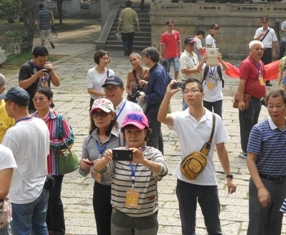‘ China undisputed leader in booming travel market ‘ : ITB

Berlin : Asia is once again among the major forces driving the international tourism market in 2013 according to the findings of the annual ITB World Travel Trends Report, conducted by IPK International and commissioned by the world’s leading travel trade show.
According to its figures Asia posted impressive growth. The Chinese were particularly frequent travellers while the usually strong Japanese market experienced difficulties. In the international travel market China is now the world’s number one when it comes to travel spending. It ranks second for total trips and fourth for overnights.
Overall, during the first eight months of 2013 international departures from Asia increased by eight per cent. At 26 per cent, the Chinese contributed significantly towards this trend, whereas the Japanese travelled two per cent less. The forecasts for next year are similar. The Chinese market is expected to expand by around 18 per cent, while the Japanese market is predicted to remain stable. Overall, Asian source markets are expected to grow by around nine per cent in 2014.
This year’s increase in travellers consolidated China’s top placing in Asia. In 2012 Chinese citizens undertook around 45 million trips abroad and spent approximately 84.4 billion dollars. As a result the Chinese market was about twice the size of Japan’s. Other Asian markets appear small in comparison to China. Korea, Hong Kong, Australia, India and Indonesia followed in the rankings for total international trips.
This year’s figures for arrivals in Asia were equally positive. According to the World Tourism Organization (UNWTO), between January and August international arrivals grew by 6.3 per cent compared to 2012. Southeast Asia in particular experienced increased demand and reported 12 per cent growth. Visitor numbers arriving in southern Asia rose by six per cent. At four per cent, growth rates in the Pacific remained stable. Arrivals in northeast Asia rose by only three per cent, a three per cent drop compared to 2012.
Among Asian nations the Chinese were the most eager to travel. In 2013, stays exceeding four overnights rose by 28 per cent, while short trips increased by around 21 per cent. This sharp increase meant the Chinese were the world biggest spenders abroad, averaging 1,765 US dollars per trip. They travelled mainly for private reasons, with holiday trips rising by 30 per cent this year. Round trips were in demand, as were city breaks and beach holidays. At six per cent, the business travel market grew moderately compared to 2012.
Typically for a growth market, the Chinese travelled mainly within Asia, while long-haul trips to Europe and America took second place. The boom seems set to continue: experts predict the Chinese will be just as eager to travel in 2014. Around 44 per cent of the respondents from China said they aimed to travel more next year.
Focus on a fast-growing middle class
China’s positive market developments are mirrored by a demographic shift that is characterised by a fast-growing, wealthy middle class. Despite this, only seven per cent of Chinese citizens earn more than 15,000 dollars a year, in continuing contrast to nations such as Japan, South Korea and Taiwan.
Compared to China however, Japan’s performance was poor. International trips there fell by an overall two per cent, while overnights and spending dropped by three and six per cent respectively. The business travel market suffered worse than holiday trips and the lack of eagerness to travel hit Asian countries harder than long-haul destinations. Round trips, once a popular market segment, fell by around 20 per cent. However, this was largely offset by an increase in city breaks and beach holidays. Despite Japan’s economy being on the road to recovery very few of the respondents from Japan said they aimed to travel more abroad next year. Consequently, this market will probably stagnate in 2014.
Overall, forecasts predict a growing eagerness to travel over the next few years, due mainly to economic growth and an expanding middle class that is both educated and young. Furthermore, budget airlines such as Air Asia have made travelling abroad much easier and affordable.
Commenting, Dr. Martin Buck, director of Travel and Logistics at Messe Berlin, said: “People from Asia expect the same standard of hospitality and service when they travel to destinations abroad. What is more, as well as group tours, which is the traditional form of travel, individual trips are now becoming more popular in Asia. European tour companies and hotels with a focus on travel business from Asia must tailor their services accordingly.“
At the ITB Berlin Convention Rolf Freitag, president of IPK International, will present the findings of the World Travel Monitor® for the entire year, as well as the latest forecasts for 2014. The World Travel Monitor® is based on the findings of representative interviews carried out with more than 500,000 people in over 60 global travel markets.
Dec. 16, 2013















